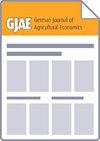农业发电对耕地利用的经济和农艺影响——以斯图加特地区为例
IF 1.5
4区 经济学
Q4 AGRICULTURAL ECONOMICS & POLICY
引用次数: 0
摘要
为了在2045年实现德国的气候中和目标,必须大幅扩大光伏和风能的使用,这可能会引发新的冲突。特别是地面安装的光伏系统,它通常与高土地消耗率有关,与农业等其他土地用途相冲突。由于同时发电和农业使用,农业发电(AV)系统可以提高土地利用效率,这就是为什么它们成为政治焦点。在这项研究中,我们超越了以往研究中有限的逐点分析,这些研究主要集中在技术本身和单个作物的潜在产量变化上,并提供了AV潜力的空间明确分析。这是通过对斯图加特地区(德国和欧洲最重要的城市之一)可耕地的深入分析来完成的。研究的重点是该地区的农艺效应和相关的农业经济效应。该分析是通过综合土地利用模型进行的,该模型通过最大化农场一级的毛利率来优化耕地利用。法律框架条件(如区域规划)被视为约束条件,并使用了AV下产量影响的现有研究。结果表明,通过提高农业毛利率存在协同效应。根据所做的基本假设,这些协同效应可以在研究区域约3%的可耕地上实现。研究区域超过10%的耕地用于AV,每公顷AV的平均毛利率减少约280欧元。种植特殊作物(如草莓)比例较高的农场或地区显示出最高的盈利能力。另一方面,轮作中块根作物占比高的地区似乎不太有利于建立AV。这表明,在综合评估AV设施的土地利用效率时,必须考虑农业土地利用结构。我们的研究结果有助于决策者更好地评估AV对土地利用的影响,并有助于确定优先实施领域,例如在区域或土地利用计划中。本文章由计算机程序翻译,如有差异,请以英文原文为准。
Economic and Agronomic Impacts of Agrivoltaics on Arable Land Use at the Example of the Stuttgart Region
Photovoltaics and wind energy must be considerably expanded to achieve the targeted climate neutrality in Germany in 2045 which may cause new conflicts. Especially ground-mounted photovoltaic systems, which are often associated with a high land consumption rate, conflict with other land uses such as agriculture. Due to the simultaneous electricity generation and agricultural use, agrivoltaics (AV) systems can increase land use efficiency which is why they are in the political focus. In this study, we go beyond the limited point-wise analyses of previous studies which have focused mainly on the technology itself and potential yield changes of individual crops and provide a spatially explicit analysis of the AV potential. This is done by an in-depth analysis on the example of arable land in the Stuttgart Region, one of the most important conurbations in Germany and Europe. The study focusses on the resulting agronomic effects in the region and the associated agro-economic effects. The analysis is carried out with an integrated land use model that optimises arable land use by maximising gross margins at the farm level. Legal framework conditions such as the regional plan are considered constraints, and existing studies on yield effects under AV are used. The results show that there are synergies through increases in the agricultural gross margins. These synergies could be realized on about 3% of arable land in the study region subject to the underlying assumptions made. With more than 10% of the arable land in the study region used for AV, the average gross margins in arable farming decrease by about 280 € per ha of AV. Farms or areas with a high share of special crops, such as strawberries, demonstrate the highest profitability. On the other hand, regions with a high share of root crops in the crop rotation seem to be less favourable to establish AV. This demonstrates that, the agricultural land use structure must be considered in the holistic assessment of the land use efficiency of AV installations. Our results help policymakers better assess the effects of AV on land use and are useful for identifying priority implementation areas, for instance, in regional or land use plans.
求助全文
通过发布文献求助,成功后即可免费获取论文全文。
去求助
来源期刊

German Journal of Agricultural Economics
AGRICULTURAL ECONOMICS & POLICY-
CiteScore
1.60
自引率
20.00%
发文量
0
期刊介绍:
The GJAE publishes a broad range of theoretical, applied and policy-related articles. It aims for a balanced coverage of economic issues within agricultural and food production, demand and trade, rural development, and sustainable and efficient resource use as well as specific German or European issues. The GJAE also welcomes review articles.
 求助内容:
求助内容: 应助结果提醒方式:
应助结果提醒方式:


